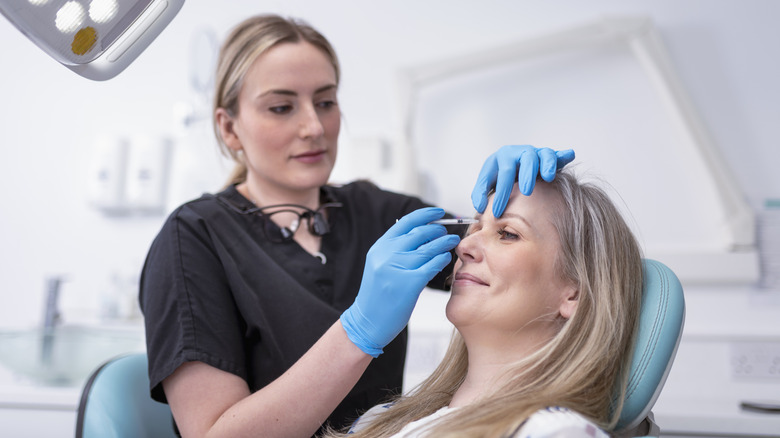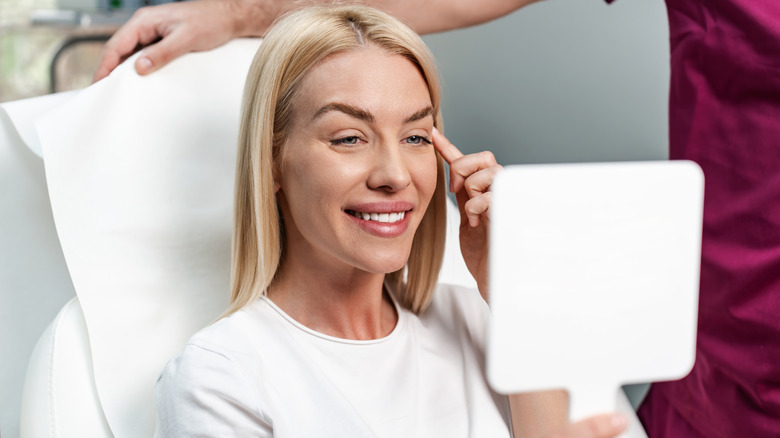What Happens To Your Face When You Stop Botox?
As far as cosmetic procedures go, Botox is one of the less-invasive options on the market. Patients are injected with tiny needles containing a toxin that will temporarily freeze their muscles, which prevents those muscles from forming or worsening wrinkles. It can even smooth existing lines. There's minimal downtime, and as long as you're not scared of needles, the procedure itself is pretty mild. One of the downsides of Botox is that it's temporary, so you'll need to keep up treatments to continue seeing results. But what happens if you suddenly decide to stop one day?
"If Botox is properly administered to reduce facial wrinkles, there is no harm in stopping treatment," explains Dr. Allen Foulad, who's board-certified in facial plastic and reconstructive surgery and the founder of Allen Foulad MD Inc. "Once the effects wear off, muscle activity gradually returns, and the wrinkles that were previously softened will slowly reappear." Speaking exclusively to Glam, Dr. Foulad notes that when you stop Botox injections, you're simply "allowing the natural aging process to continue" rather than freezing the movement of those muscles.
So, if you decide that Botox isn't working for you, you can just not go back. "There's no need to taper off Botox treatments," Dr. Foulad reiterates. "You can stop at any time without adverse effects. The product naturally wears off within a few months, and muscle activity gradually returns. Because of this flexibility, some patients use it consistently for long-term results, while others use it selectively for special events." There's nothing wrong with stopping cold turkey, but there are ways to get the most out of your Botox if you do decide to continue.
How should Botox be used for the best results?
Botox doesn't need to be gradually stopped to avoid any negative side effects, but if you do decide to keep it up, working out a personalized treatment plan with your practitioner would be wise. This applies whether you're getting preventative Botox or corrective Botox. "Most patients return for Botox treatments every three to four months, but this timeline can vary," Dr. Allen Foulad explains exclusively to Glam. "The longevity of results depends on multiple factors, including individual metabolism, the specific muscles treated, and the dosage used." If you notice that the intended effects of your Botox wear off sooner than other people you know, you may simply need to return for more frequent treatments.
"Although higher doses can prolong the duration of effect, I typically prefer a more conservative dosing approach," Dr. Foulad continues. "While lighter dosing may require slightly more frequent treatments, the overall amount of Botox used throughout the year is often lower, and the outcome tends to be more natural-looking." To prolong the effects and avoid any adverse reactions, make sure you don't make the most common mistakes after getting Botox. These include getting other facial treatments, even touching your face with too much pressure (this can cause the product to move around), and drinking alcohol, which can increase your chance of bruising.
Why you might need to stop Botox
There are several reasons why someone might want to suddenly discontinue Botox use. For starters, the treatment isn't effective for everyone, and given that it's temporary, the costs can certainly add up. Each treatment can set you back $300 to $600 on average, and this is an ongoing expense if you want to maintain your results. One of the other reasons you might want to stop is the presence of adverse effects, which Dr. Allen Foulad notes is possible particularly when you're not working with an experienced provider. " ... excessive use of Botox, particularly at high doses over long periods, can lead to notable muscle atrophy," he tells Glam exclusively.
TikTokker Brenda Blay took to the platform in 2023 to explain that she'd experienced muscle atrophy after using Botox for 20 years. Though more research is needed around Botox-related muscle atrophy, the risks can be mitigated with breaks and smaller doses. "By strategically using lower doses, we can maintain natural facial movement while minimizing the risk of side effects," he confirms.
Dr. Foulad explains that problems can also arise when only one part of the muscle receives Botox, as the part that's not injected may try to compensate. "This imbalance can sometimes result in increased wrinkling in adjacent areas, highlighting the importance of precise technique and thoughtful dosing," he shares. If you have any concerns after your Botox treatment, contact your doctor immediately. Add ifyou're interested in Botox but afraid of needles, there are other treatments to try instead, including microdermabrasion, chemical peels, and laser therapy.


